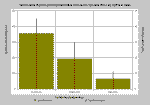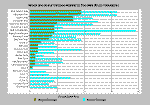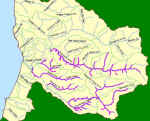Bibliography Background About KRIS
Hypothesis #4: A Reduced supply of large wood has contributed to the loss of pool habitat and the decline of coho salmon in the Ten Mile River basin.
Support for the hypothesis from the literature
Stillwater Sciences (1997) studied the history of large wood removal in Mendocino County for the Louisiana Pacific Corporation as part their Sustained Yield Plan. They advanced this hypothesis as part of their report:
"One of the working hypotheses concerning coho salmon ecology and management in Mendocino County streams is that large woody debris (LWD), and the rearing habitat that it provides, may currently be the most important factor limiting coho populations. The well-documented role of LWD in coho salmon ecology, combined with the observation that the recent decline of coho salmon in California appears to be somewhat coincident with large-scale LWD removal programs led quite naturally to this hypothesis."
Large wood is an extremely important element in helping create and maintain fish habitat diversity, especially in coastal streams (see Big Wood page). Among many fish habitat creating and maintaining roles, large wood ameliorates excess sediment supply (Kelley et al. 1995), and may also help keep streams cool by forcing more flow into shallow ground water (Poole and Berman 1999). The function of large wood apparently most fundamental for coho salmon, however, is pool formation associated with bed scour. The addition of large wood to streams has been shown to increase pool frequency and coho salmon production (Cedarholm et al., 1997).
O'Connor and Ziemer (1989) found that large wood supply in the North Fork Caspar Creek reflected timber harvest activities from 100 years prior. A predominance of fir and alder in the North Fork Caspar Creek was explained as the result of early succession of harvested riparian zones, and the authors suggested that large wood supply may actually decrease due to a centuries-long delay in recruitment of the long-lasting redwood. Surfleet and Ziemer (1996) returned to the North Fork Caspar Creek after 60% of that basin was clear-cut around riparian buffers in 1992, and comparatively studied the South Fork Caspar Creek where 60% of the basin was selectively cut without riparian buffers and where stream-cleaning activities occurred twenty five years earlier. The study supports the importance of riparian buffer strips for providing the recruitment of large wood to streams and further documents the wood supply deficit from historic logging and stream cleaning.
Stillwater Sciences (1997) reviewed stream clearance reports obtained from California Department of Fish and Game files and generated a map of where, within the Noyo and Big River areas, large wood removal activities were believed to occur by decade (see KRIS Big River). The report provides evidence that wood removal activities in the Mendocino coastal area have dramatically altered stream channels and available fish habitat. The report includes, for example, an account that bed scouring of 10-20 ft occurred in some stream segments following large wood removal. See Stream Clearance for more on the topic of removal of wood from streams as part of early restoration efforts.
From the KRIS Ten Mile Database
CDFG memos available in the KRIS Bibliography document large removal activities in Bear Haven Creek, Booth Gulch, the Little North Fork, O'Connor Gulch, Cavanough Gulch and the South Fork Ten Mile during the period 1982-1984. Additional records for the same period were found and summarized by Hawthorne Timber Company. The records document extensive wood removal throughout the South Fork sub-basin, the Middle Fork sub-basin (except Bear Haven Creek), and Mill Creek.
No surveys of large wood in the stream channels of the Ten Mile have been conducted, but habitat typing surveys by Georgia-Pacific in 1996 provide information on the amount of habitat formed by large wood. An analysis of that habitat data (CRWQCB, 2001) found the proportion of stream habitat formed by large wood is correlated with where coho salmon were found in the Ten Mile basin. Of all Ten Mile River tributaries where temperature was not a limiting factor, coho salmon persisted only in those streams where 9% or more of the habitat area was formed by large wood. Smith Creek, Campbell Creek, and Churchman Creek may have enough wood-formed pool habitat to support coho in recent years, but less than in Bear Haven Creek and the Little North Fork where removal activities did not occur.
Habitat typing surveys also generated data on pool frequency and pool depth which show that the availability and quality of pool habitat is generally low in the Ten Mile River basin (see Habitat Information page). This data is used in Hypothesis 2 as supporting evidence for how increased sediment has changed habitat, but the role of wood is also important in pool formation. USFS Vegetation data show that riparian stands in the Ten Mile River basin contain fewer large trees (>20 inch diameter) than small trees. This suggests depletion of riparian zones associated with timber harvest (see Hypothesis #5) and reduced opportunity for recruitment of large wood to stream channels. It therefore seems likely that depleted levels of large wood will continue to limit coho salmon habitat in the Ten Mile River basin.
Supporting Topics in KRIS:
(BW) Wood: Removed Jams in 1982
(BW) Habitat: Wood and Scour Formed Habitat by Area
 This chart shows the number of log jams removed from streams in three areas of the Ten Mile River basin by CDFG in 1982 and the length of surveys and cleaning projects in miles. The work generally removed 6-8 log jams per stream mile where crews worked (356 log jams over 45 miles in the South Fork, 193 log jams over 30 miles in the Middle Fork). The majority of work in the "mainstem" area actually occurred in Mill Creek. See map below.
This chart shows the number of log jams removed from streams in three areas of the Ten Mile River basin by CDFG in 1982 and the length of surveys and cleaning projects in miles. The work generally removed 6-8 log jams per stream mile where crews worked (356 log jams over 45 miles in the South Fork, 193 log jams over 30 miles in the Middle Fork). The majority of work in the "mainstem" area actually occurred in Mill Creek. See map below.
 The percent of habitat area formed by scour or large wood is charted at left for all surveyed Ten Mile River basin tributaries (1995-1996). Streams are ranked by the percent of habitat formed by large wood. Bear Haven Creek and the Little North Fork rank highest (19%) and are two of the very few tributaries not subjected to known wood removal activities. The five highest ranking tributaries (add Smith, Campbell, and Churchman Creeks) had persistent presence of coho during the period 1994-1998. All other tributaries have less 9% habitat area formed by large wood.
The percent of habitat area formed by scour or large wood is charted at left for all surveyed Ten Mile River basin tributaries (1995-1996). Streams are ranked by the percent of habitat formed by large wood. Bear Haven Creek and the Little North Fork rank highest (19%) and are two of the very few tributaries not subjected to known wood removal activities. The five highest ranking tributaries (add Smith, Campbell, and Churchman Creeks) had persistent presence of coho during the period 1994-1998. All other tributaries have less 9% habitat area formed by large wood.
From KRIS Maps
 This map image shows in pink the reaches of the Ten Mile River basin where wood removal activities were conducted by CDFG in 1982-1984 according to work reports. The North Fork Sub-basin was evidently spared from wood removal during this period. CDFG reports are available in the bibliography. The map was created by Hawthorne Timber Company from summary tables.
This map image shows in pink the reaches of the Ten Mile River basin where wood removal activities were conducted by CDFG in 1982-1984 according to work reports. The North Fork Sub-basin was evidently spared from wood removal during this period. CDFG reports are available in the bibliography. The map was created by Hawthorne Timber Company from summary tables.
 This USFS vegetation coverage from the KRIS Ten Mile Map project shows a 90 meter riparian influence zone for the entire Ten Mile basin. Over all, the dominant condition is early seral with Saplings (1-4.9" diameter), Small Trees (5-11.9" diameter) and Small-Medium (12-19.9" diameter) characteristic of many riparian reaches (note mainstem SF, and lower NF and MF) with Medium/Large trees (20-29.9" diameter) occurring only in patches. While some Non-Forest habitat is associated with timber harvest adjacent to Class III streams, riparian areas in the west reflect the estuary, farm land and pasture adjacent to the stream while those in the east are in part owing to natural grasslands and mixed oak woodlands. Lack of large trees within 90 meters of the stream reduces potential large wood recruitment, which in turn limits pool formation and coho salmon productivity.
This USFS vegetation coverage from the KRIS Ten Mile Map project shows a 90 meter riparian influence zone for the entire Ten Mile basin. Over all, the dominant condition is early seral with Saplings (1-4.9" diameter), Small Trees (5-11.9" diameter) and Small-Medium (12-19.9" diameter) characteristic of many riparian reaches (note mainstem SF, and lower NF and MF) with Medium/Large trees (20-29.9" diameter) occurring only in patches. While some Non-Forest habitat is associated with timber harvest adjacent to Class III streams, riparian areas in the west reflect the estuary, farm land and pasture adjacent to the stream while those in the east are in part owing to natural grasslands and mixed oak woodlands. Lack of large trees within 90 meters of the stream reduces potential large wood recruitment, which in turn limits pool formation and coho salmon productivity.
Alternative Hypothesis
Large wood removal was of little consequence, pool frequency dropped for other reasons as did coho abundance.
Support of this alternative would be similar to evidence used to support Hypothesis #2. That is that sedimentation may be such a dominant limiting factor that large wood could not compensate for reduced pool volumes. High water temperature could also be a competing mechanism for coho decline as advanced in Hypothesis #3.
Monitoring Trends to Support or Refute the Hypothesis
Large wood could be added to streams with low numbers of coho to see if juvenile carrying capacity would increase. Experiments are already being conducted by the California Department of Fish and Game (Collins, 1999) to determine if adding large wood to the stream improves pool frequency and depth in Parlin Creek, in the Jackson Demonstration State Forest. Monitoring of large wood supply should follow standard methods (e.g. Schuett-Hames et al. 1999) so that wood levels can be compared among streams of the region.
References
Cedarholm, C.J., R.E. Bilby, P.A. Bisson, T.W. Bumstead, B.R. Fransen, W.J. Scarlett and J.W. Ward. 1997. Response of Juvenile Coho Salmon and Steelhead to Placement of Large Woody Debris in a Coastal Washington Stream. North American Journal of Fisheries Management. 17:947-963.
California Department of Fish and Game (CDFG). 1982. Fish habitat improvement completion form for Bear Haven Creek (Ten Mile River tributary). No author. CDFG unpublished file memo. Yountville, CA. 2 pp.
California Department of Fish and Game (CDFG). 1983a. Booth Gulch (Middle Fork Ten Mile River tributary) stream survey, 14 June 1983. CDFG unpublished file memo from M. Kidd to A. Grass. Yountville, CA. 3 pp.
California Department of Fish and Game (CDFG). 1983b. Cavanough Gulch (North Fork Ten Mile River tributary) stream survey, 11 June 1983. CDFG unpublished file memo from M. Kidd to A. Grass. Yountville, CA. 3 pp.
California Department of Fish and Game (CDFG). 1983c. Little North Fork Ten Mile River (Ten Mile River tributary) fish habitat improvement completion form. CDFG unpublished file memo. Yountville, CA. 3 pp.
California Department of Fish and Game (CDFG). 1983d. O'Connor Gulch (North Fork Ten Mile River tributary) stream survey, 15 June 1983. CDFG unpublished file memo from M. Kidd to A. Grass. Yountville, CA. 1 p.
California Department of Fish and Game (CDFG). 1983e. South Fork Bear Haven Creek (Bear Haven Creek tributary) field notes, 4 July 1983. CDFG unpublished file memo, by A. Grass. Yountville, CA. 1 p.
California Department of Fish and Game (CDFG). 1983f. Virgin Creek (Pacific Ocean tributary) field notes, 02 June 1983. CDFG unpublished file memo, by M. Kidd. Yountville, CA. 1 p.
California Department of Fish and Game (CDFG). 1984. Fish habitat improvement completion form for South Fork Ten Mile River. No author. CDFG unpublished file memo. Yountville, CA. 2 pp.
California Regional Water Quality Control Board (CRWQCB). 2001. Assessment of aquatic conditions in the Mendocino coast hydrologic unit. North Coast Region, CRWQCB. Santa Rosa, CA. 284 pp. [947k]
Collins, B.W. 1999. Parlin Creek Large Woody Debris Placement Project. Jackson Demonstration State Forest Newsletter. Volume 51 (Spring/Summer). CA Department of Forestry and Fire Protection, Mendocino Ranger District.
O'Connor, M.D., and R.R. Ziemer. 1989. Coarse woody debris ecology in a second-growth Sequoia sempervirens forest stream. Proceedings of the California Riparian Systems Conference: protection, management, and restoration for the 1990's. September 1988, Davis, California. U.S. Department of Agriculture, Pacific Southwest Forest and Range Experiment Station (PSW): p. 165-171. Gen. Tech. Rep. PSW-110.
Poole, G.C., and C.H. Berman. Submitted. Pathways of human influence on water temperature dynamics in stream channels. Environmental Management. 20 pp.
Schuett-Hames, D., A.E. Pleus, J. Ward, M. Fox, and J. Light. 1999.</a> TFW Monitoring Program method manual for the large woody debris survey. Prepared for the Washington State Dept. of Natural Resources under the Timber, Fish, and Wildlife Agreement. TFW-AM9-99-004. DNR #106. 66 pp.
Surfleet, C.G., and R.R. Ziemer. 1996. Effects of forest harvesting on large organic debris in coastal streams. Pages 134-136 in: LeBlanc, John, ed., Conference on Coast Redwood Forest Ecology and Management, 1996 June 18-20, Humboldt State Univ., Arcata, CA.
Stillwater Sciences. 1997. A review of coho salmon life history to assess potentially limiting factors and the implications of historical removal of large woody debris in coastal Mendocino County. Prepared by Stillwater Sciences, Berkeley CA for Louisiana-Pacific Corporation, Wildlife and Fisheries Science Group, Forest Resources & Fiber Procurement Division. May 1997. 55 pp